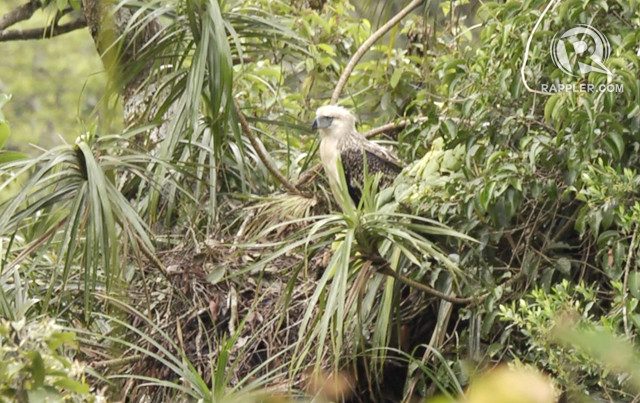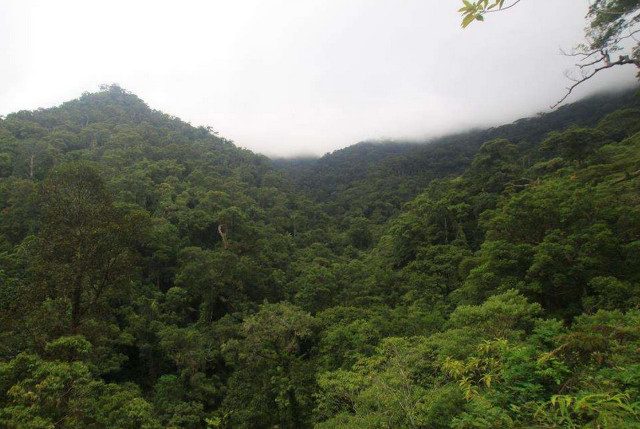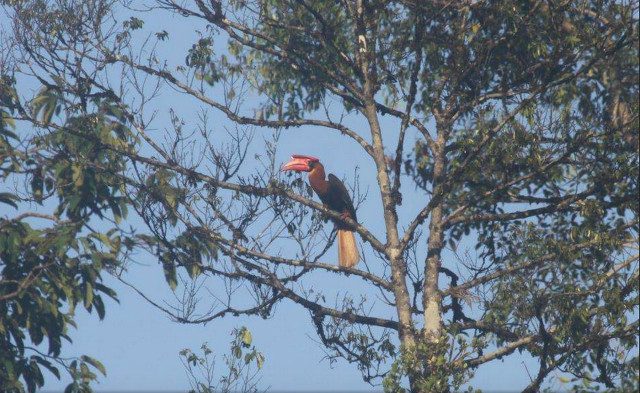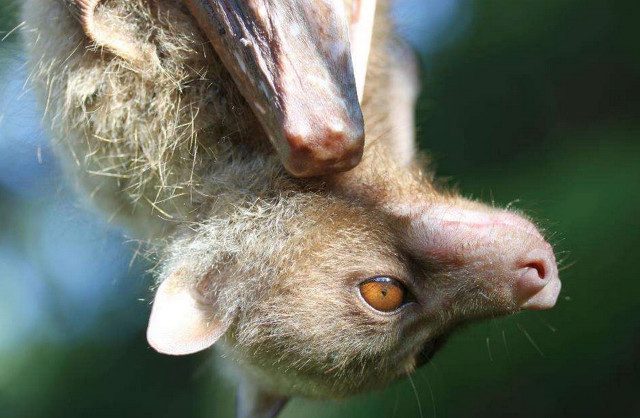SUMMARY
This is AI generated summarization, which may have errors. For context, always refer to the full article.

On the outer rim of a nest almost completely camouflaged by leaves stood a bird with brown feathers, a smooth head that sometimes fanned out into a crown, and the fierce stare that could only belong to a Philippine eagle.
It was a 3-month-old male eaglet enjoying a drizzly morning perched on the first active Philippine eagle nest discovered on Luzon island.
Biologists of the Philippine Eagle Foundation (PEF) first came upon it in April, after 4 years of trekking through dense mountain forests in Apayao province.
Philippine eagles, the country’s national bird, is listed as critically-endangered by the International Union for the Conservation of Nature. Only around 400 pairs remain in the wild.
The nest and its precious eaglet would not have been there if not for the surrounding pristine forests.
Having an eagle here is doubly important because it provides justification for protecting large natural areas.
– Dennis Salvador, PEF
PEF biologists credit a local conservation method that not only guards the forests with stiff penalties but has made it sacred ground.
In certain areas of the province, large swathes of forest have been declared as lapat, a word that means “sanctuary” or “reserve” for the Isnag ethnic community.
The declaration was formalized with local laws that turned areas under lapat into “Indigenous Protected Areas.”
“This is probably the only local government we’ve worked with that had a headstart already in protecting its own forest,” PEF Executive Director Dennis Salvador told Rappler.
Culture for conservation
Lapat is primarily a religious practice, not a conservation method.
A parcel of forest land is declared lapat after its Isnag owner dies, turning it into an off-limits area out of respect for the spirit of the owner who is thought to be wandering in his lapat.
Lapat is lifted only when the family of the dead holds festivities for the entire tribe.

The ordinance simply adopted the traditional practice as a conservation method.
Salvador said the traditional nature of lapat is key to its success in protecting Apayao forests and the biodiversity gems tucked within it.
“Because it is by nature traditional and very deeply rooted in the culture, everyone understands it, everyone subscribes to its policies and are basically well informed of the penalties if you break the code. Culturally, the people basically monitor themselves.”
The punishment for disobeying the lapat rules is no laughing matter. Anyone caught hunting, fishing or gathering wildlife is fined between P10,000 to P50,000 ($221-1,100) and will have to provide free labor for 3 months.
The ordinance is backed up by enforcement. A few months ago, around 20 Isnags became forest guards or “green guards” assigned to watch over parts of the lapat area.
Green guard Marlon Busiguit said they attended a seminar where they were taught how to spot illegal loggers and how to handle trespassers. They were told to bring trespassers to the village captain who answers to the mayor.
Treasures of biodiversity
The effectivity of these local efforts are best proven by the state of wildlife in the forests.
A few steps into the trail, we were already greeted by two Rufous Hornbills or Kalaw, one of the rarest birds in the country and a mainstay on international lists of critically-endangered species.

Further afield are rare primary or old-growth forests with 10-storey-high lawaan or dipterocarp trees, some wider than average human height.
Biologist Meriljn Van Weerd of the Mabuwaya Foundation, who has been studying Apayao biodiversity since 2010, said it’s home to the rarest and largest flower in the world, the Rafflesia. If you’re lucky, you might even see the Mottle-winged Flying Fox, an animal that has only been observed 10 times in history.
Apayao is a sanctuary for 139 bird species, 61 of which are endemic and 4 threatened.
Its richness has prompted Van Weerd to nickname Apayao the “hidden treasure trove” of Philippine biodiversity.
Despite this, the Apayao mountain forests are not protected by national legislation, unlike say, Mount Pulag in Benguet or Apo Reef in Occidental Mindoro.

Even the lapat system may not be enough of a safety net in the long-run, said Salvador.
“By nature, officials get elected and re-elected and so it’s very temporal. Having a law to protect this place through a republic act, for instance, gives a sort of permanence in terms of protecting this site.”
Proof that Apayao forests are home to the threatened national bird may increase chances of protection by legislation.
“Having an eagle here is doubly important because it provides justification for protecting large natural areas. Eagle being a very territorial species, and requires large natural areas to survive and reproduce. This gives justification for local officials to get a better protection for a much larger area,” Salvador explained.
Safeguarding Philippine forests has never been more critical.
Only 23% of the entire Philippine landmass is still forested, the second lowest forest cover in Southeast Asia, after Singapore, according to 2010 data from the Department of Environment and Natural Resources.
The country’s primary forests, home to very old native species, have dwindled to only 6% of the Philippine landmass.
The Apayao mountains are one of the last remaining strongholds of these original forests.
In the meantime, the Isnags of Apayao are careful to guard their treasure. Scientists will continue studying the Philippine eagles in hopes of reviving their population.
But guarding a national treasure may require a national commitment. – Rappler.com
Want to support the Philippine Eagle Foundation? Call them at (+6382) 324-1860, 0917-719-8093 or email them at info@philippineeaglefoundation.org
Add a comment
How does this make you feel?
There are no comments yet. Add your comment to start the conversation.